Modeled and Observed Ocean Heat Content - Is There a Discrepancy?
Posted on 25 May 2012 by dana1981
Recently there have been a number of claims of a large discrepancy between modeled and observed ocean heat content (OHC), for example by Roger Pielke Sr., David Evans, and Bob Tisdale. All of the associated analyses by these individuals focus on a paper by Hansen et al. (2005), Earth's energy imbalance: Confirmation and Implications, published in Science. In this paper, Hansen et al. ran a NASA Goddard Institute for Space Studies (GISS) climate model to, among other things, simulate the change in OHC of the upper 750 meters of global oceans from 1993 to 2003 (Figure 1).
Figure 1: OHC change between 1993 and 2003 in the top 750 meters of world ocean. Observations are from Willis et al. (2004). Five model runs are shown for the GISS coupled dynamical ocean-atmosphere model. From Hansen et al. (2005).
As you can see, from 1993 to 2003 the 0-750 meter OHC increase was close to 6 Watt-years per square meter (W yr/m2), accounting for an energy accumulation of approximately 0.6 W/m2 over that period.
We recently discussed the newest OHC results from Levitus et al. (2012), who estimate the 0-2000 meter OHC increase from 1990 to 2009 at about 14 x 1022 J, accounting for an energy accumulation of about 0.45 W/m2 (Figure 2).
Figure 2: Time series for the World Ocean of ocean heat content (1022 J) for the 0-2000m (red) and 700-2000m (black) layers based on running pentadal (five-year) analyses. Reference period is 1955-2006. Each pentadal estimate is plotted at the midpoint of the 5-year period. The vertical bars represent +/- 2 times the standard error of the mean (S.E.) about the pentadal estimate for the 0-2000m estimates and the grey-shaded area represent +/- 2*S.E. about the pentadal estimate for the 700-2000m estimates. The blue bar chart at the bottom represents the percentage of one-degree squares (globally) that have at least four pentadal one-degree square anomaly values used in their computation at 700m depth. Blue line is the same as for the bar chart but for 2000m depth. From Levitus et al. (2012)
So Hansen et al. predicted a 0.6 W/m2 energy accumulation in the upper 750 meters of oceans from 1993 through 2003 (and approximately the same accumulation through 2011), whereas Levitus et al. observe a 0.45 W/m2 accumulation in the upper 2000 meters. Thus the three individuals above conclude that we have a significant model-data discrepancy here. Are they right?
Unfortunately, the answer is not a simple one.
Problematic OHC Data
The first challenge in answering this question lies in the difficulty in measuring OHC, which prior to the implementation of the ARGO float network around 2003, was measured with instruments like expendable bathythermographs (XBTs), which have biases that are difficult to correct for.
Estimates of the OHC increase are not very consistent. For example, Levitus et al. (2012) estimate the 0-700m increase from 1993 to 2003 at 0.44 W/m2, while Lyman et al. (2010) estimate it at approximately 0.6 W/m2. If the Levitus estimate is correct, then Hansen's model overestimated the OHC increase. If the Lyman estimate is correct, so was the model.
Recent Data, Deeper Oceans
Although the model run in Hansen et al. (2005) did not project OHC changes beyond 2003, we can estimate that they would continue increasing roughly linearly, and thus that the associated post-2003 energy accumulation should continue to be close to 0.6 W/m2 if the model mean is correct.
A second challenge involves the fact that over the past decade, the 0-700m OHC increase has slowed primarily because more heat has gone into the 700-2000m layer. This short-term deeper ocean heat storage is consistent with the "Hiatus Decades" predicted by Meehl et al. (2011). During "Hiatus Decades," there is less warming of the surface air and shallow oceans, and more warming of the deeper oceans (Figure 3), precisely as we've observed over the past decade, as Levitus et al. (2012) found.
Figure 3: Left: composite global linear trends for hiatus decades (red bars) and all other decades (green bars) for top of the atmosphere (TOA) net radiation (positive values denote net energy entering the system). Right: global ocean heat-content (HC) decadal trends (1023 J per decade) for the upper ocean (surface to 300 m) and two deeper ocean layers (300–750m and 750 m–bottom), with error bars defined as +/- one standard error x1.86 to be consistent with a 5% significance level from a one-sided Student t-test. From Meehl et al. (2011)
This does create a model-data discrepancy for the 0-700m ocean layer in most instances. However, the 0-2000m OHC measurements are fairly consistent with GISS model predictions.
-
Willis et al. (2004) estimate the 0-750m OHC accumulation from 1993 to 2003 at 0.6 W/m2
-
von Shuckmann et al. (2009) estimate the 0-2000m OHC from 2003 to 2008 at 0.54 W/m2
-
von Schuckmann & Le Traon (2011) estimate the 0-2000m OHC increase from 2005 to 2010 at 0.42 W/m2
-
Levitus et al. (2012) estimate the 0-2000m OHC from 2000 to 2010 at 0.5 W/m2
-
Loeb et al. (2012) estimate the 0-1800m plus abyssal OHC from 2001 to 2010 at 0.5 W/m2
-
Hamon et al. (2012) estimate the 0-700m OHC from 1993 to 2007 at ~0.55 W/m2
-
Lyman et al. (2012) estimate the 0-700m OHC from 1993 to 2011 at 0.5 W/m2
These observational estimates predominantly over the ARGO era are somewhat lower than the GISS-EH model predictions (approximately 0.7 W/m2 for the whole ocean). However, note that thus far we have only examined one model OHC estimate (GISS-ER), but there are of course many other climate models. The other GISS model used in the 2007 IPCC report, GISS-EH, estimates the 0-700m OHC increase at closer to 0.5 W/m2 and 0-2000m closer to 0.6 W/m2, which is probably more consistent with the observations listed above. Domingues et al. (2008) also show the OHC simulation results from a number of climate models in their Figure 2.
Inaccurate, Unskeptical Graphs
One problem amongst the various OHC model-data comparison graphs created by some of the contrarians listed above has been the most popular of the 5 characteristics of scientific denialism: cherrypicking. In fact, several cherries have been combined into an über-cherrypick.
The first cherrypicks have already been discussed above - ignoring OHC below 700 meters, and ignoring the OHC increase prior to 2003. The latter cherrypick is particularly egregious considering that the model results being examined from Hansen et al. (2005) were from 1993 to 2003.
Tamino identifies the third cherrypick, which he describes as a misrepresentation. This one involves shifting the OHC anomaly data downward and/or the modeled OHC trend upward such that they align in 2003 (in other words, cherrypicking the anomaly baseline). In reality, there was a large spike in OHC from about 2001 to 2003, so 2003 was well above the long-term trendline. Tamino illustrates the third cherrypick in Figure 4 below.
Figure 4: OHC data from NODC (black) and linear fit from 1993 to 2002 (red), linear extrapolation of that trend (blue), and Bob Tisdale's depiction of the predicted trend (green). David Evans created a graphic almost identical to Tisdale's as well.
By choosing the baseline such that the models and data are equal in 2003, Tisdale and Evans have graphically exaggerated a model-data discrepancy.
Accurate Graph
I discussed the purported model-data OHC discrepancy with Gavin Schmidt of NASA GISS and the RealClimate blog; many thanks to Gavin for his helpful responses to my inquiries. Our discussions resulted in a correction and update to model-data comparisons at RealClimate (Figure 5).
Figure 5: Individual GISS-ER climate model OHC simulations (blue dotted lines) and the ensemble average (heavy blue line) vs. OHC annual average (thick black line) and OHC seasonal variability (data point for every 3 months; thin black line).
As noted above, the GISS-ER model simulations are fairly consistent with the Lyman OHC reconstruction, but expect a greater OHC increase than in the Levitus reconstruction, including over the last decade (if the model simulations are extrapolated forward).
Remaining Unresolved Questions
OHC changes remain uncertain in both models and observations. As Figure 1 shows, the Hansen et al. (2005) five 1993-2003 OHC simulations varied from energy accumulations of 0.5 to 0.65 W/m2. There is also a 0.1 W/m2 difference between the mean OHC accumulation in the two GISS models discussed here, and of course there are also many other global climate models. There is too much uncertainty to say for certain if there exists an OHC model-data discrepancy, but it is a possibility.
Hansen et al. (2011) provides a very interesting discussion of this issue. In this paper, the authors note that there is a continuum of possible combinations of human aerosol forcing strength and OHC mixing efficiency. The strength of the aerosol forcing remains a large uncertainty, potentially ranging anywhere from -1 to -2 W/m2 at present.
On the one hand, we have good measurements of global surface temperature, and climate models have accurately projected global warming of the surface, indicating that the climate sensitivity in those models is accurate, as confirmed by paleoclimate data.
On the other hand, we have these two significant uncertainties regarding the actual radiative forcing and the efficiency of OHC mixing. For example, if the aerosol cooling effect is stronger than we think, but oceans don't mix heat as efficiently as we think, climate models will still accurately simulate the surface warming. The same is true if the aerosol forcing is weaker, but ocean heat mixing is more efficient than in climate models. Hansen et al. (2011) weighed in with their conclusion on this matter:
"We conclude that most climate models mix heat too efficiently into the deep ocean and as a result underestimate the negative forcing by human-made aerosols. Aerosol climate forcing today is inferred to be -1.6±0.3 W/m2, implying substantial aerosol indirect climate forcing via cloud changes."
The Hansen et al. inferred aerosol forcing is about 33% larger than the 2007 IPCC best estimate of -1.2 W/m2.
Remaining Uncertainties - Good News and Bad News
The good news here is that if Hansen et al. are right, there is less of an OHC energy imbalance than we think, and thus less "warming in the pipeline" from the CO2 we've already emitted. Hansen describes the bad news as a "Faustian Bargain" in which more warming results as we inevitably reduce human aerosol emissions. Overall the good and bad news should roughly offset in terms of future surface warming.
In any case, while the OHC issue is not entirely settled in either models or observational data, climate contrarians have exaggerated the possible disrepancy between the two through their standard scientific denial practice of cherrpicking data. It will be interesting to see how this issue is resolved in the coming years as observational data and climate models improve, and in the forthcoming IPCC Fifth Assessment Report, but in the meantime exaggerating the possible discrepancy is neither constructive nor truly skeptical behavior.































 Arguments
Arguments





















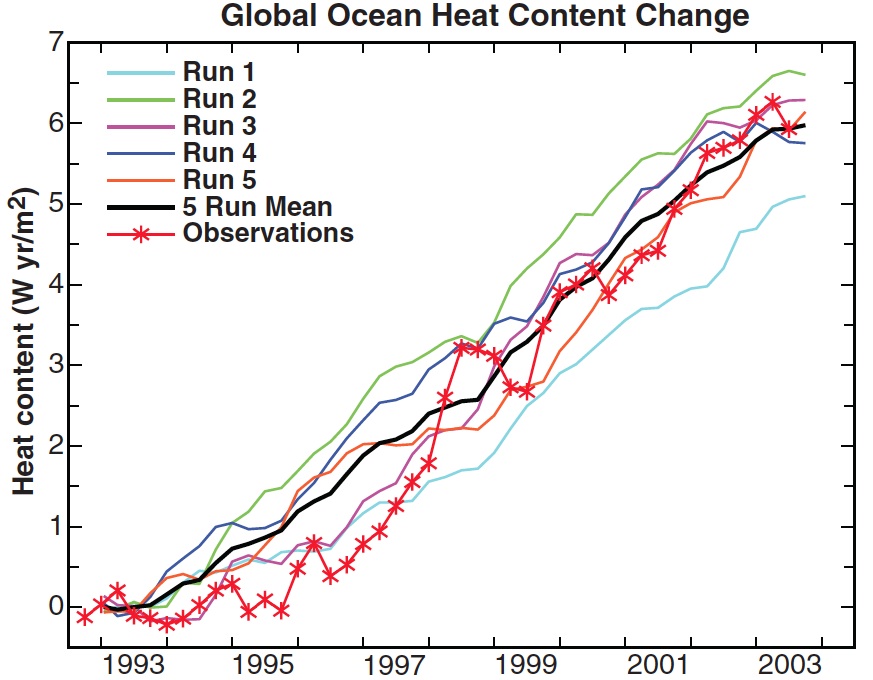
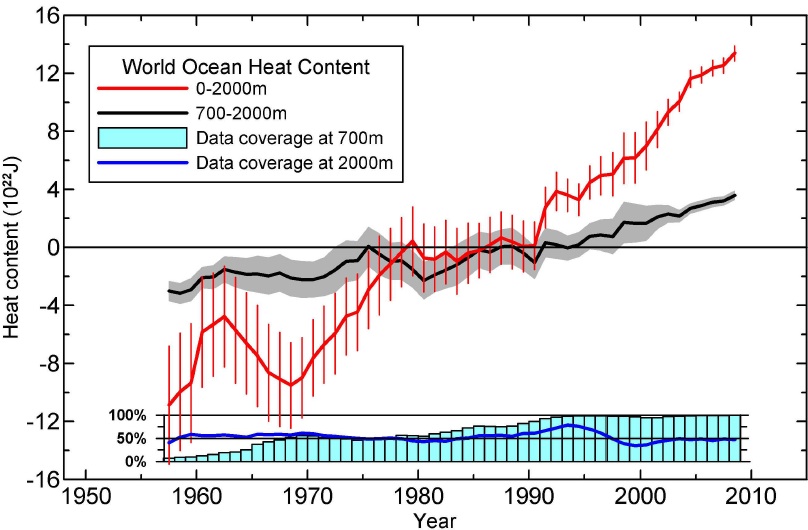
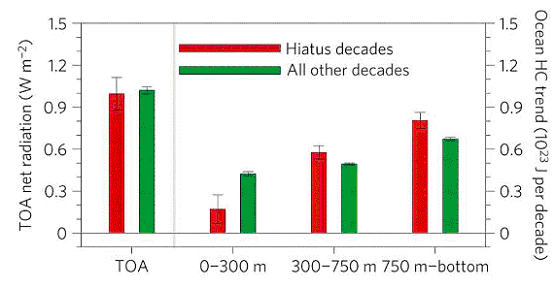
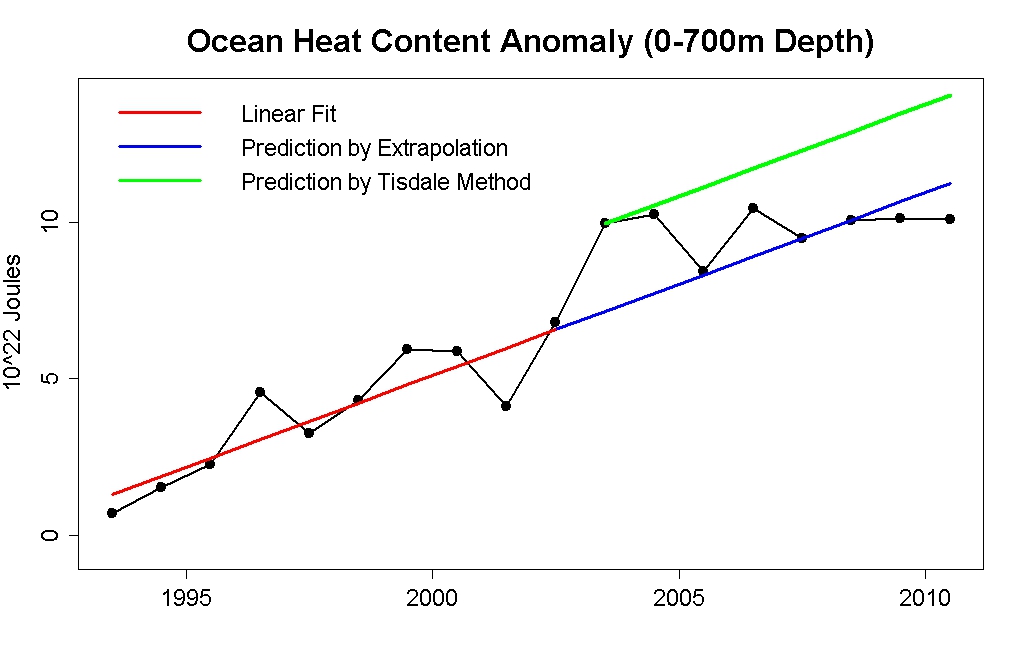
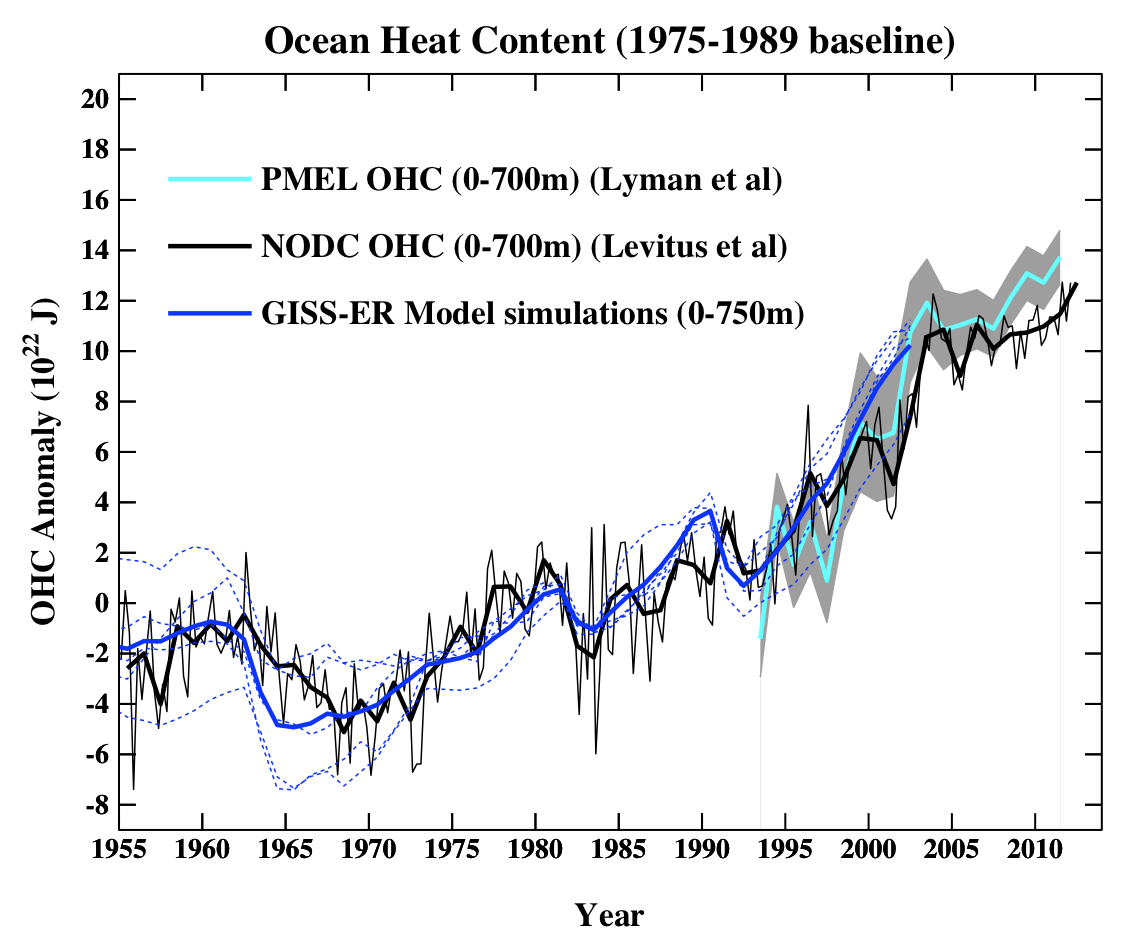









[DB] Somehow you missed the link to the Updated Comments Policy, with its strictures against inflammatory tone being especially relevant.
Note that dialogue here is best-considered a two-way street, with an observance of the Comments Policy being given more than a passing nod.
[Albatross] Somehow the second half of my post disappeared. I'll do my best to reproduce the original.
[DB] Text and graphic restored. And don't ask how. ;)